This is the 1st insights digest of Segmanta’s Moms in Asia 2020 study. We piloted the research in 9 Asian areas to find out what motherhood means to moms globally and how their lives are affected by it.
Segmanta is opening up 2020 with a brand-new study, exploring what the moms around the world need, want and wish for, as well as to provide marketers informative directions. We conducted a comprehensive survey in 9 areas in Asia for starters to ask the mothers (with children under 3 years old) about their general motherhood experience, purchasing habits, physical/mental well-being, parenting styles, attitudes towards technology, social media consumption and so forth. Over 11,000 moms across the areas completed our survey.
With rapidly growing middle class and influential shopping styles, Asian consumers will soon become the global leading shoppers. From the results, we see shopping behaviors vary by region and by product category. Understanding how the mothers or household grocery decision-makers are influenced by price and brand is crucial to the baby/kid companies.
In the survey, we implemented a number of rating questions to evaluate the key elements to consider when buying baby/children clothing, food products, toys, and medicine. The most price-sensitive and the most brand-sensitive stuck out based on the importance ratings in each category (1 as the least important, 5 as the most important). We also listed out the countries/regions that rated the highest and the lowest.
Clothing – Overall score: Price 3.7 | Brand 2.6
The first thing we noticed: the respondents are the most price-sensitive towards the clothing category. Children grow up fast and the clothing purchases happen rather frequently. Mothers shy away from high-priced baby/children apparel out of financial concerns. Japanese moms are the most likely to rate “price” as important (4.2) while Indian moms rated the least important (3.2). Regarding the brand, Indian moms rated it the highest (3.1, close to neutral) while Japanese and Korean moms rated the lowest (2.2). In general, the audience cares about price but does NOT really care about brands. The results indicate that Asian moms prefer a cost-effective solution for children’s clothing consumption. Thus, lower-priced, more pragmatic options are popular among Asian mothers.
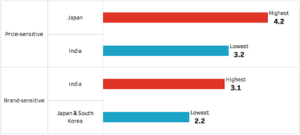
Food Products – Overall score: Price 3.5 | Brand 3.3
As for food products, moms from the Philippines rated the highest (3.9) while Indian moms rated the lowest (3.0, neutral). Regarding food brands, Indian moms are affected by it the most (4.2) and Japanese moms the least (2.5).
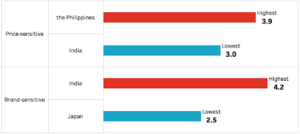
Unlike in Western countries, kid-specific food options are widely available. In many Asian families, mothers prepare meals according to the fathers’/partners’ needs, aka adult food, which the children start eating once they come of age. Rice-based soft food, congee, puree, and cereal are the usual homemade supplements in Asia. Once the young children are able to eat adult food, the mothers reduce the amount of baby food they buy and fit the kids into a feeding style like the adults. Therefore, marketers should focus on younger children with specific feeding requirements and establish a strong, noticeable brand image to keep your audience engaged, aiming to form a healthy, balanced eating habit for the children later on in life.
Toys – Overall score: Price 3.6 | Brand 2.6
In regard to toy prices, moms from the Philippines rated the highest (3.9) while Indian moms rated it the lowest (3.3, still somewhat important). Meanwhile, the overall respondents declared that toy brands are NOT important. The parents are keener on buying educational toys to enhance the kids’ development through entertainment within a reasonable price range. In recent years, the market for smart toys has grown popular. Brand sensitivity might fluctuate with some of the major smart toy-makers in the game as they take advantage of the increasing awareness of tech-infused toys and e-commerce to entice their customers.
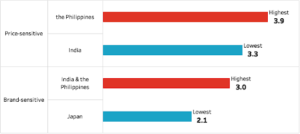
Medicine & Nutritional supplements – Overall score: Price 3.5 | Brand 3.7
If the branded medicine is more expensive, so be it. For the price of children’s food products, moms from the Philippines rated the highest (3.9) while Japanese moms rated it the lowest (3.1, close to neutral). For brands, Filippino moms rated it the highest (4.2) and Japanese moms rated the lowest (2.9, close to neutral). Compared to generic medicines, well-known medicine brands are trusted by a larger audience. Renowned medicine brands clearly have an advantage over Asian mothers, who will spare no money and effort for their children’s well-being. Interestingly, Japanese moms do NOT consider brands as a key element for children’s medicine.
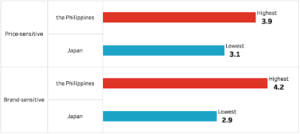
Other Fun Findings
Aside from price and brand, what other criteria Asian mothers care about the most in each product category?
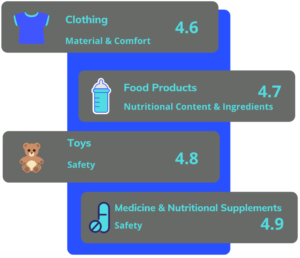
All the factors that were rated the most important are either related to customers’ trust in the brands and companies or related to the baby/children’s well-being. Additionally, convenience is another critical aspect to win over Asian mothers. The moms prefer the convenient design, aka easy to put on and take off, such as slide-on shoes and zippers. “Safety” was voted the most important factor in purchasing medicine and supplements. For food products, “nutritional value” was elected the most important. “Ease of preparation” is voted the second-highest as saving moms’ time cooking is a bliss. Meanwhile, the “educational value” and “entertainment value” of toys are both popular aspects to consider among Asian moms.
To Marketers & Brands
According to the survey results, here are a few key items to look out for while targeting mothers in the Asian market:
First, localization is key. Even though geographically connected, the moms from different countries have their own way of consumption. Tailor your pricing/brand strategy to fit the local mothers’ demands, mindsets and preferences will increase targeting efficiency.
Second, the price and brand sensitivity might be influenced by culture, the value of the currency, the overall economic development, and parenting styles. In areas that are of slower economic growth, creating value for your customers and boosting cost-effectiveness is more efficient.
Third, the brands should influence the customers(since they are extremely social media active) through omnichannel marketing and entice the audience with incentives or promotional offers. Asian mothers are heavily influenced by the recommendations of brands. To enhance brand reputation and establish customers’ trust is critical to further steer the customers towards their brands.
Finally, utilizing ethically gathered declarative data to improve market segmentation and targeting strategy should become a common practice in the research stage of baby product marketing.

